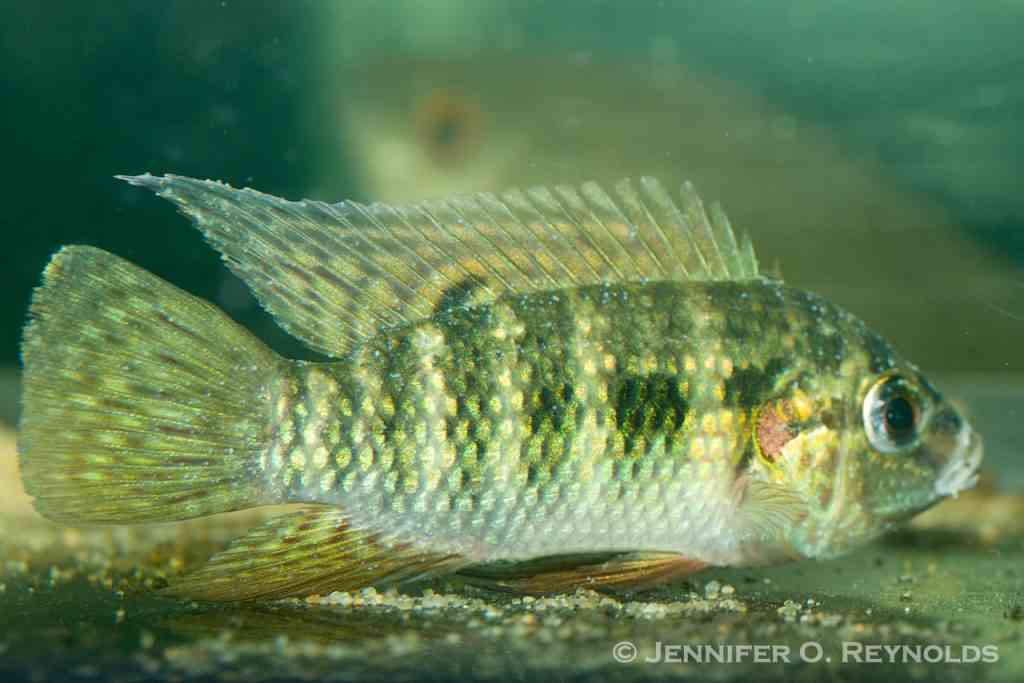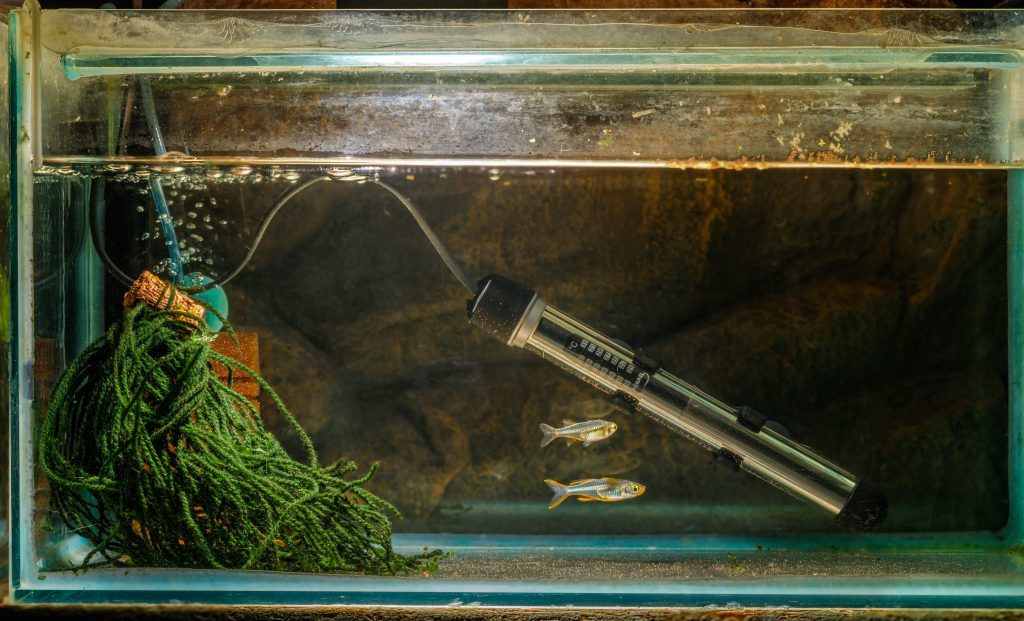Nora Hickey, D.V.M. & Jennifer O. Reynolds, M.A.

Nora and Jen examine common causes of white spots on fish and focus on the persistent and common aquarium fish disease, Ich, differentiate it from Epistylis, and discuss common myths and potential treatment options.
Jen: So Nora, one topic that comes up a lot on the groups and forums I follow locally is people struggling to know how to treat sick fish. Not only do we have limits on medications we can access here in Canada where I am, but there seems to be a lot of mythology disguised as fact running rampant on various internet sources about two specific diseases, Ich and Epistylis.
From your veterinary perspective, what are these diseases? How are they different and how are they similar?
Nora: This is a timely question Jen, because I just ran across a post on Reddit describing Epistylis as a “bacterial infection that is best treated with antibiotics.” Both Ichthyophthirius multifiliis (most commonly referred to as “Ich”) and Epistylis are parasites that infest the skin and gills of fish. The differences between these two parasites stem from how they move and feed. Epistylis is a sessile ciliate parasite. This means that it does not move; it attaches to the fish’s skin with its stalk, and then it waves the little cilia around its mouth to suck in bacteria in the water (its food source). By contrast Ich is a motile ciliate. When you look at it under a microscope, it is moving around and feeding on the fish’s skin and gills. This obviously causes a lot more damage than Epistylis and makes Ich a primary pathogen that can kill healthy fish without any help from poor environmental conditions or other pathogens. Ich infestations require aggressive treatment, whereas Epistylis is more of an opportunistic pathogen. It takes advantage of poor environmental conditions (water that has a lot of organic debris in it) and wounds. Just improving environmental conditions alone can resolve Epistylis infestations in fish.
Jen: When I was at the Vancouver Aquarium we had a lot of Epistylis in our system. We had plants, driftwood, a lot of shared system water and a heavy organic load despite new water being constantly dripped in. We rarely considered it an emergency though. If a fish seemed badly afflicted they often recovered after being separated and placed in a prolonged 3 ppt salt bath. Usually there was some underlying factor that caused the fish to be more susceptible, like you’re saying. Sometimes it was open wounds caused by aggression from other fish, damage from tank decor, or that the fish was immunocompromised in some way, maybe from chronic mycobacteriosis infection (which is a big topic for another conversation).
If we had seen Ich in our system though, it would have been an emergency. Using careful quarantine methods kept this issue out of our main system, at least not afflicting the fish visibly, for all the years I was there.
When I was there though, we could easily perform skin scrapes to determine what parasite we were dealing with. Home hobbyists don’t have this advantage, so lots of advice online says that Ich is flat to the body, or doesn’t go on the eyes, etc. Is there any way for a home aquarist to truly differentiate these visually?
Nora: You can’t tell what is causing skin lesions on a fish unless you do diagnostic testing, usually microscopic examination of skin and gill wet mounts. You are right that the Internet is full of people who have all sorts of advice about how to differentiate fish skin diseases based on the size of the lesions, the color of the lesions, the location of the lesion on the fish’s body, whether they are raised or flat, etc. Having actually done the diagnostics on all sorts of different skin lesions, I would caution people that you cannot accurately identify what is causing white spots on a fish just by looking at it. You never really know what you’re going to find until you evaluate it under the microscope–and it is incredibly important to get the right diagnosis, because your fish will not get better if you are treating the wrong thing.
Ich versus Epistylis is a great example. Let’s say that you have a betta fish with some white lesions on its skin; you assume it is Epistylis and do a 3 ppt salt bath for a day or two. If your fish has Ich, this treatment will not work, and your fish will continue to decline. On the other hand, let’s say that you have an Ancistrus with some white lesions on its skin; you assume it is Ich and treat it with a malachite green/formalin product–and then it dies because these guys can be super sensitive to those drugs. It might have just had Epistylis, which you could have fixed with some water changes and a few salt dips.
Jen: I think one of the big challenges here is that it isn’t realistic for most home aquarists to always get to the “right” diagnosis without the diagnostic tools that professionals have. So when I was trying to assist a local hobbyist with white dots on her fish, while looking at the picture she provided, it looked like classic Ich to me, but I knew I couldn’t be certain. She had planned to treat for Epistylis using an antibiotic based on a lot of online info. Now, we do have to acknowledge that Epistylis can be associated with bacterial infections, which can also result from the conditions we identified above: water quality issues, heavy organic loads, overcrowding, wounds, etc.
The other thing that was missing for me in assisting this person was context. Had she added new fish recently? If so, I might be thinking Ich. Had she had a major heater malfunction and cold shock to the fish recently? Again, could indicate Ich. Had the tank been established for a while now with no notable events? What was the water quality? I didn’t know. Maybe Epistylis is more likely in that kind of scenario.
Ultimately though I felt she would be better off treating for Ich, knowing we couldn’t be certain which it was. Some Ich treatments should impact Epistylis seeing as they’re both ciliates, right? If she treated for an underlying bacterial infection hoping to address a root cause of presumed Epistylis, the Ich would certainly progress and kill the fish. Treating properly for Ich should deal with the Ich, obviously, and might help with Epistylis. Meanwhile, she should consider the root causes of disease appearing on her fish and try to address them. Without the ability to make the absolute right diagnosis, one is better off thinking of it this way than assuming they’re correct on a diagnosis that’s mostly impossible for a home aquarist to confirm. What do you think of this thought process Nora?
Nora: Jen, I could not agree with you more that antibiotics are not the way to go when fish have white spots on their skin. The most likely (and most treatable) causes of white spots on fish skin are parasites. You bring up a great point that this case is missing a lot of context that would help evaluate the likelihood of which particular parasite is the cause. New fish introductions would make you much more suspicious of Ich (versus Epistylis, which is an organism that probably exists in many home aquariums without causing problems). You bring up a great point that drugs that work for Ich will also work for Epistylis–and many other types of external parasites. The difference in treating Ich versus Epistylis is mainly in the frequency of treatments–Ich has parts of its life cycle where it is resistant to treatment, so you need to do multiple strategically-timed treatments to completely eliminate it.
I love your focus on finding a root cause, though. Whether it is Ich or Epistylis (or something else we haven’t even discussed here), what happened or is happening that is making her fish unwell? All of the parasite treatments in the world will not help a fish in poor environmental conditions. Supportive care is critical for sick fish; even if you have a correct diagnosis and are using the correct treatment, you should be doing tons of water changes and making the environment as perfect as you can to support your fish while in their recovery.
Jen: Absolutely, preventing the problem in the first place is going to be a much better strategy. I think we’ve all heard the saying–modified for the metric folks out there–a gram of prevention is better than a kilogram of cure. Particularly so for our Canadian hobbyists, who are dealing with poor availability of the usual over the counter treatments due to Health Canada removing them from shelves in 2019. That makes using quarantine and maintaining the optimal environment for each fish species more important than ever. There are also non-treatment tools that can help such as UV filters.
Nevertheless, if a home aquarist has found themselves in the unfortunate position of trying to handle white dots on their fish (which could be Ich, Epistylis, or other), could you give us a round up of accessible treatment options they can look into, with considerations such as invasiveness, species it could be problematic for, and special considerations?
Nora: If your fish has white spots on its skin and you can find a veterinarian willing to see it, I highly recommend relying on them to correctly diagnose and effectively treat the problem; however, I know it can be hard to find a veterinarian for fish, so here are some tips if your fish have white spots.
There are quite a few possible causes: parasites (including Ich and Epistylis, but there are several others we didn’t talk about here), water molds/fungi, viruses, and even cancer. Jen, you were “spot on” in your assessment that some causes of white spots are more concerning than others–and that these causes vary in how easily they can be treated–or if they can even be treated at all.
A conservative approach to treating fish with white spots on their skin could include increasing the water temperature, performing daily water changes (up to 100% if possible), adding salt to the aquarium (1-3 ppt), and doing higher-dosage salt dips (up to 32 ppt, depending upon what the fish species will tolerate). Some species tolerate salt better than others. I had some cardinal tetras that got an Ichthyobodo infestation from a Synodontis eupterus I added without quarantining (embarrassing), and when I tried salt dipping them, they went belly up immediately upon contact with the salt dip solution. They were fine when moved back to freshwater, but obviously salt was not a safe treatment option for them. It’s worth pointing out that while salt is generally safer than other treatments like formalin/malachite green, it can be underwhelming in its actual parasite-killing effect. If you have fish where you suspect Ich, you likely want to take a more aggressive approach to treating your fish.
There are many over-the-counter products available to treat all sorts of fish diseases. I try to avoid using them because they do not have proven safety, efficacy, or purity, and they haven’t been produced following the good manufacturing practices required for approved animal drugs–but many hobbyists don’t have any other options. So, buyer beware of over-the-counter fish drugs. Ingredients like formalin, malachite green, hydrogen peroxide, acetic acid, and copper can be expected to have some action against both external parasites and water molds/fungi; many of these chemicals have human health risks, so always make sure to inform yourself about proper safety measures for any chemicals you use in your aquarium. Products with malachite green should be avoided in certain species, in particular catfish and loaches, as they do not seem to handle this drug well. Copper can be highly effective but also highly toxic; its dosing requires knowing the alkalinity of the water being treated–the details of treating with copper could be a good topic for a future conversation!
I’ll leave you with a final very simple (but perhaps not easy) way to treat Ich. If you move the infected fish into a new tank with clean water everyday for 1-2 weeks (alternating fish back and forth between two tanks would work if they are emptied and disinfected each time), you can disrupt the parasite’s life cycle with no need for drugs. Obviously this is not practical for every situation, but I think it is quite easy to do for bettas and small community fish tank set ups. And it avoids using chemicals that can harm your fish–and you!
Reputable Resources:
Noga EJ. Fish Disease : Diagnosis and Treatment. Second edition. Wiley-Blackwell; 2010.

